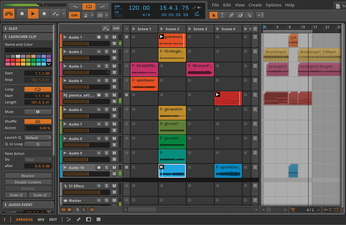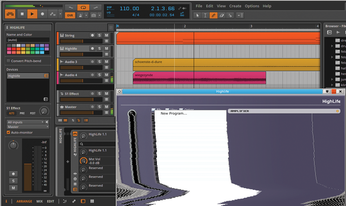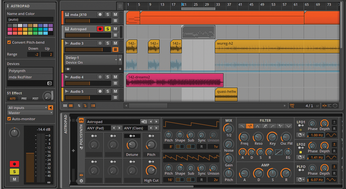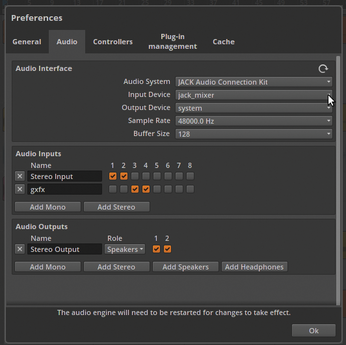The Bitwig Studio DAW transforms Linux computers into music workstations
Loopy
Bitwig comes from the electronica scene; thus, it offers a variety of options for working with loops, in addition to all the usual functions for classical recording of handmade music.
The program offers the usual loop functions, such as analysis tools for finding individual tones in sound samples and determining the probable bpm (beats per minute) speeds of samples. The samples can be adapted to the project speed without changing the pitch. In the tracks, you can put together loops with the mouse pointer on the right edge of the sound clips.
Bitwig Studio also has a special, fully loop-oriented project view. The Clip Launcher is a matrix that follows the tracks vertically but forms an arbitrary number of columns horizontally – Bitwig calls them "scenes" (Figure 4).

The Scene columns contain boxes that can record MIDI or audio loops. Bitwig Studio does not trim the clips to a standard length; rather, it plays their entire content in a loop. The signal is sent to the output of the track that forms the respective level in the scene; it can be edited in the mixer, just like the sounds recorded in the normal Arranger tracks. A mouse click is all it takes to enable empty boxes for recording from the sound card, assuming recording is enabled for the track in question.
You could use this approach to, say, record an eight-bar drum pattern on one track, record 12 bars of bass in another box, and then put your guitar solos in other boxes. Bitwig ensures that the tracks are cued in sync on the first beat – at least the beginning of the recording – and it repeats the material of all your active clips for as long as you want. You do not need to drop the clips into the same Scene column to do this. The program also plays multiple clips on the same track at the same time.
The only other easy-to-use application for Linux that lets you do something similar is Seq24 [3]. However, the program is a pure MIDI sequencer; it does not have its own sound producer and cannot be used with audio recordings.
Solid Teamwork
Plugins are responsible for creating and editing sounds in today's music software. Bitwig Studio exclusively supports VST plugins natively compiled for Linux. It cannot do anything with LADSPA or LV2, and any VST effects in the Windows DLL format installed on Linux also do not appear in the plugin list.
In the Bitwig Browser (at the far right), the first tab is Devices and Presets, and in our lab, it only listed VST plugins compiled as native Linux libraries after I added the /usr/local/lib/vst and /usr/lib/vst directories as Library Locations. Both synths and effects from MDA, linuxDSP, and Loomer then worked perfectly, just like the built-in modules.
For a good overview of VST software that is natively available for Linux, visit the linux-vst website [4]. Although Bitwig Studio was built for 64-bit systems, it can still use 32-bit plugins as well (see also the "Tips and Tricks Online" box).
Tips and Tricks Online
Bitwig Studio comes with a 300-page, easily understandable PDF manual. Bitwig itself and the growing community of fans also provide documentation and instructions on the Internet.
The Bitwig YouTube channel [5] offers a wide selection of video tutorials. They are characterized not only by hands-on skills but also by brevity and their focus on the essentials.
The Bitwig Tutorials [6] page offers an unofficial collection of Bitwig how-tos. The Traktor Bible [7] page, which offers a variety of aids for using the Traktor sequencer, has announced a similar project for Bitwig for the future.
The Bitwig Studio plugin interface lets you interconnect several plugins to create new, more complex modules that behave internally as coherent modules. This nesting (Figure 5) represents a first step toward a fully modular construction kit This plugin interface with the flexibility of a modular synthesizer is announced for Bitwig Studio 2.0. I had the opportunity to see a working experimental version of this in action.

To keep problems with third-party plugins in check, Bitwig Studio processes extensions separately from its own audio engine. Under Options | Preferences | Plug-in management, you can select whether to run all the plugins in a shared container (Global processing for all plug-ins) or individual modules in their own containers (Independent processing for each plug-in). This means that Bitwig's audio processing can remain fully operational in the event of a plugin crash; the crashed module can be restarted with a single click (Figure 6).

The automatic plugin scan worked perfectly in our lab, from a purely technical point of view. The plugin management tool displays everything and automatically identifies problems in an installed module. However, the Linux VST modules installed on the test computer did not appeared in the Devices section of the browser. In the Files section to the right (Figure 7), everything was fine, and I was able to drag all the virtual devices from there into the project.

Macros
You can usually set all sorts of parameters on virtual sound generators. Much like their role models made of sheet metal and electronics, software synthesizers and effects typically offer a variety of controls that let you design sounds. Unlike hardware devices, however, you can also adjust all the parameters via software. For example, all adjustable parameters follow automation curves that you draw in the Arranger tracks.
Bitwig takes this one step further: If you can do this with automation curves, why should you not be able to attach parameters to any curve function? In the world of synthesizers, such functions existed well before the first digital plugins; they are usually known as envelopes or LFOs. In Bitwig, you will also find these classic curve generators, but you can apply the function to any parameter and to several parameters simultaneously.
If you click on the white arrows below the LFOs, you can apply the function to any parameter, even to effects that are not directly part of the synth whose LFO you are using. With an active arrow, move the mouse cursor to the parameter you want the envelope to follow. Suitable parameters are highlighted in light green or blue. After clicking, the mouse pointer changes to an up/down arrow. When you move this, a light green area appears on the controller that is controlled by the LFO from now on.
LFO envelopes are pre-programmed curve functions that give the user many options. However, arbitrary audio recordings can also be regarded as curves – in Bitwig, curves derived from normal sounds can also be applied to plugin parameters. In the toolbox with the internal Bitwig plugins, first click on the FX box top right; then, click the plus sign on the right and choose Audio Mod from the list below Modulators.
Audio Mod can be connected with the audio output of a track in the project, but Bitwig does not yet automatically find signals in the current Jack network. Once the track is playing something, the module generates an envelope from the sound, which you can then apply like a standard LFO. For example, a filter that attenuates a synth can follow a snare drum on any track in the project. The synth must be installed in the Audio Mod by clicking on FX module.
Bottom left in the Device box, a double arrow, the Presets and Macros button, opens a section with eight assignable sliders when clicked. These sliders, which are referred to as macros, do not have their own curve functions; they are designed to let you operate several controllers from a single point (Figure 8). The mapping works as described for the LFOs; moving the mouse pointer up and down the during assignment defines the control path. This means you can select the maximum value range that you want to control and avoid extreme settings where applicable. Macros can also follow envelopes and automation lines.

Jack in the Box
Bitwig is pretty much perfectly integrated with Linux in terms of the installation and its interface. However, for music software, it is at least as important that the program can also set up the authoritative Jack and ALSA MIDI Linux audio environments.
In this respect, Bitwig Studio is still a little ambiguous. On one hand, the audio engine is rock solid. No scratches or dropouts occur even in hour-long sessions with a high system load. With 30 and more tracks, several synthesizers, and dozens of effects, this is a remarkable achievement. Bitwig cannot be persuaded to cause disturbances in Jack either, despite wild experiments with automation and sound manipulation.
On the other hand, Bitwig also lacks some features that other programs for Jack offer by default. Although Bitwig identifies both the sound card connections and the outputs of the native Jack programs running at the same time as Bitwig, you cannot combine them individually with arbitrary internal Bitwig ports, unlike Ardour or Qtractor. Instead, you need to decide on one Jack port provider under Options | Preferences | Audio. Whereas Ardour lets you simultaneously record the output of the Guitarix virtual guitar amplifier on one track and the microphone connected to your sound card on another, Bitwig makes you choose one or the other.
This deficiency can be ironed out using the Jackmixer utility. Bitwig detects all the ports that you create in Jackmixer as if they were "physical" sound card inputs. If you choose Jackmixer as an audio input in Bitwig, the Audio Inputs section offers you a numbered list of all Jackmixer ports. With a few experiments, you can quickly find out which number belongs to which Jackmixer port and then connect it with the internal ports created in Bitwig (Figure 9). This means that you can cleanly and separately record synthesizers such as Alsa Modular Synth and Yoshimi, or effects such as Calf or Guitarix, in Bitwig. After selecting Jackmixer as an input, you need to restart Bitwig for the settings to take effect.

After the restart, Bitwig not only connects with Jackmixer, it also shows the internal ports it created for Jackmixer in QjackCtl. These can then be connected to the Jack outputs of applications such as the Guitarix guitar amplifier or soft synths such as Alsa Modular Synth. For this to work in the future, you need to launch Jackmixer with the ports that Bitwig detected as set up before starting Bitwig; otherwise, Bitwig reports an error and refuses to set up a single input.
The audio problem can be solved by creating ports for Jackmixer, but things look less rosy for MIDI devices. Although my USB keyboard could be set up as a generic MIDI keyboard, Bitwig did not recognize the notes I played on it because of a bug that interferes with Jack MIDI. In Version 1.0.8 this problem is partially solved. Bitwig now works with external MIDI ports when the virmidi module is loaded with:
modprobe snd-virmidi
If you rely on a MIDI keyboard, you will thus want use the Bitwig demo [8] to test whether your model can be used with Bitwig.
Bitwig offers an open JavaScript API for connected hardware, so one hopes that this ugly problem will disappear as more and more devices are integrated into the somewhat cumbersome Bitwig connection by manufacturers and knowledgeable owners.
Conclusions
Bitwig Studio presents itself as a perfectly designed, professionally built, complete software for musicians. Especially for compositions and live performances, its Clip Launcher matrix offer options that are new on Linux. The automation functions also prove to be highly developed. The modular structure of the plugin section offers a flexibility rarely seen from other commercial programs.
The price of US$ 400 (EUR 300, UK£ 260) appears tolerable, considering that the complex technology of Bitwig Studio works perfectly and stably on Linux; it makes efficient use of available computing power and otherwise acts in all respects as you would want any native Linux application to behave.
If classic studio programs for Linux, like Ardour or Qtractor, fail to satisfy your special requirements, you could well find what you've been looking for in the form of Bitwig Studio.
Infos
- Bitwig: http://www.bitwig.com
- Download: http://www.shareit.com/product.html?productid=300623384
- Seq24: http://www.filter24.org/seq24/
- VST for Linux: http://www.linux-vst.com/
- Bitwig on YouTube: https://www.youtube.com/user/bitwig
- Bitwig tutorials: http://bitwigtutorials.net
- Traktor Bible: http://www.traktorbible.com/en/
- Bitwig demo: http://www.bitwig.com/en/bitwig-studio/download.html
« Previous 1 2
Buy this article as PDF
(incl. VAT)
